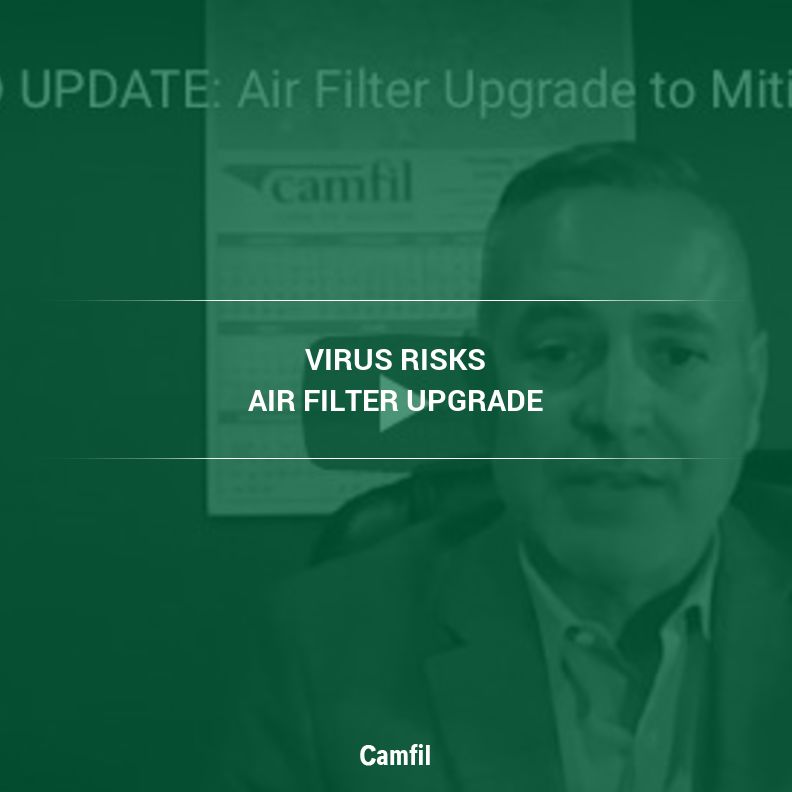Upgrading your air filtration system is a crucial step in protecting facilities and commercial buildings against the spread of the COVID-19 virus. Cognizant authorities such as the CDC and ASHRAE (American Society of Heating, Refrigerating, and Air-Conditioning Engineers) recommend an air filter with a minimum rating of MERV 13. MERV 14 is preferred. . In some jurisdictions, MERV 13 is a mandatory condition that must be met.
However, many smaller rooftop HVAC systems are configured to hold only 2-inch depth air filters. Air filters with higher MERV values are generally more effective and economical to operate if they are deeper than 2 inches. What do you do when your rooftop unit is only set up with 2-inch tracks?
In a new video, air filtration experts Mark Davidson and Joe Randolph discuss the available options for upgrading the air filtration systems in buildings with limited space for air filters.
Why Do Equipment Manufacturers Construct HVAC Equipment with 2-inch Tracks?
If 2-inch tracks don’t have the capacity to hold air filters that provide long-lasting, high-quality filtration, why aren’t they manufactured with a larger track? “Manufacturers want to maintain the integrity of the unit’s footprint,” says Camfil’s Director of National Distribution Sales for U.S. and Mexico, Joe Randolph, who has over 32 years of experience in the air filtration and HVAC industries. “In other words, 2-inch air filter tracks give OEMs the flexibility to keep many air handling units a standard size. There are millions of these units in service right now and devoting a greater area for air filters in certain models would lessen direct replacement and cost them a competitive advantage.”
Option 1: Replace Your Rooftop HVAC Handling Unit
Ideally, according to Camfil’s air filtration experts, if your budget allows for it, you should contact an HVAC mechanical contractor who can advise you on the feasibility of extending the unit size in order to accommodate larger and deeper filters. The more space you have, the more air filter options you’ll have. Having a wide range of air filters to choose from will allow you to install the highest quality air filtration available to ensure you’ve taken steps to mitigate your risk from COVID-19.
Most air filters in rooftop HVAC units with 2-inch tracks are only able to protect the coils and circulation equipment from harmful debris. They are not capable of significantly improving indoor air quality. By investing in a mechanical retrofit of your existing air handling unit so it can hold larger filters, you’ll reap the benefits that come from more effective, efficient air filters.
Option 2: Opt for a MERV-A Rated Air Filters that Provide the Same Protection.
If you can’t afford to dramatically modify existing HVAC equipment, you can still find MERV-A rated filters, but they will have a higher operational cost. Many MERV 13 rated filters (note: non-A-rated filters) use an electrostatic charge to improve the efficiency of the air filter without having to use larger amounts of filtering material. Over time, this charge dissipates and the effectiveness often degrades to approximately the equivalent of a MERV 8 filter.
Filters with a MERV-A rating have been manufactured to a MERV value without relying on an electrostatic charge, so they maintain the indicated efficiency for their entire service life. There are MERV-A 14A rated air filters that are 2-inches deep, but they will have a higher pressure drop and shorter service life. However, they will deliver MERV-14 performance so you have to decide if the operational cost is feasible in your situation. If not, one alternative would be a MERV-A 9A air filter which spends the majority of its service life performing at a higher level than charged MERV 13. “The reality is, you’re going to be getting longer life and closer to that MERV-13 recommendation,” says Randolph,
Option 3: Consider an In-Room Air Filtration Unit.
If you need or want extra protection, but can’t manage either of the above options, there are supplemental l air filtration systems available that you can use. In-room air purifiers equipped with HEPA air filtration don’t require any special infrastructure and provide among the highest level of protection commercially available.
“A stand-alone air cleaner is going to be plug and play. You’d put that air cleaner in a conference room or a lobby or a classroom, plug it into a standard outlet, and you’d be able to provide clean air to that room,” says Randolph, “The great thing about these products is that it far exceeds the CDC recommendation or even the air quality that we see in some areas of a hospital.”
About Camfil Clean Air Solutions
For more than half a century, Camfil worldwide has been helping people breathe cleaner air. As a leading manufacturer of premium clean air solutions, we provide commercial and industrial systems for air filtration and air pollution control that improve worker and equipment productivity, minimize energy use, and benefit human health and the environment. During the COVID-19 pandemic, Camfil has been applying their decades of experience in biosafety containment, healthcare, and other sectors of the air filtration industry to provide technological solutions for the public as well as in hospitals and healthcare facilities.
Media Contact:
Lynne Laake
Camfil USA Air Filters
T: 888.599.6620
E: Lynne.Laake@camfil.com
F: Friend Camfil USA on Facebook
T: Follow Camfil USA on Twitter
Y: Watch Camfil Videos on YouTube
The post COVID UPDATE: Air Filter Upgrade to Mitigate Virus Risks by Joe Randolph Camfil Expert appeared first on Air Filters for Clean Air.

